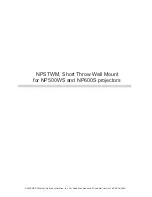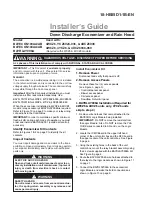
22
Remote Sumps
A remote sump located in an indoor heated space is an excellent way to prevent freezing
in the cold water basin during idle or no load conditions because the basin and associated
piping will drain by gravity whenever the circulating pump is idle. EVAPCO can provide
connections in the cold water basin to accommodate for remote sump installations.
Electric Water Level Control
Optional electric water level control packages can be furnished to replace the standard
mechanical float and valve assembly. The electric water level control eliminates the freezing
problems experienced by the mechanical float. In addition, it provides accurate control of the
basin water level and does not require field adjustment even under varying load conditions.
Please note: the standpipe assembly, make up piping and solenoid valve must be heat
traced and insulated to prevent them from freezing.
Vibration Cut Out Switches
During severe cold weather conditions, ice can form on the fans of cooling towers causing
excessive vibration. The optional vibration switch shuts the fan off avoiding potential
damage to or failure of the drive system.
Capacity Control Methods for Cold Weather Operation
Induced draft and forced draft cooling towers require separate guidelines for capacity control during cold
weather operation.
The sequence of control for a cooling tower operating at low ambient conditions is much the same as
a cooling tower operating under summer conditions provided that the ambient temperature is above
freezing. When the ambient temperatures are below freezing, additional precautions must be taken to
avoid the potential for damaging ice formation.
It is very important to maintain close control of the cooling tower during winter operation. EVAPCO
recommends that an absolute MINIMUM leaving water temperature of 6° C must be maintained;
obviously, the higher the water temperature from the tower, the lower the potential for ice formation. This
assumes that proper water flow over the tower is maintained.
Induced Draft Unit Capacity Control
The simplest method of capacity control is cycling the fan motor on and off in response to
the leaving water temperature of the tower. However, this method of control results in larger
temperature differentials and longer periods of down time. During extremely low ambient
conditions, the moist air may condense and freeze on the fan drive system.
Therefore, fans
must be cycled during extremely low ambient conditions to avoid long periods of idle time
whether water is flowing over the fill or in bypass. The number of start/stop cycles must be
limited to no more than six per hour.
A better method of control is the use of two speed fan motors. This allows an additional step of
capacity control. This additional step reduces the water temperature differential, and therefore, the
amount of time the fans are off. In addition, two speed motors provide savings in energy costs,
since the tower has the potential to operate on low speed for the reduced load requirements.
The best method of capacity control during cold weather operation is the use of a variable
frequency drive (VFD). This allows the closest control of the leaving water temperature by allowing
the fan(s) to run at the appropriate speed to closely match the building load. As the building load
decreases, the VFD control system may operate for long periods of time at fan speeds below 50
percent. Operating a low leaving water temperature and low air velocity through the unit can cause
ice to form. It is recommended that the minimum speed of the VFD be set at 50 percent of full
speed to minimize the potential for ice to form in the unit.
Содержание AT 110-112
Страница 39: ...39 ...
Страница 40: ... 2012 EVAPCO Europe Bulletin 113 E 1216 ...
















































